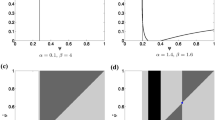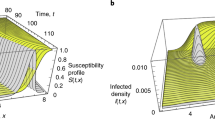Abstract
Many pathogens that are predominantly sexually transmitted can also be transmitted vertically. On the other hand, nonbeneficial pathogens that are predominantly vertically transmitted appear to be rare to absent. Many infections also exist that are only transmitted sexually. Using an empirically suggested trade-off between the horizontal and vertical transmission modes, we develop and analyze a model to study evolutionary dynamics of sterilizing, sexually transmitted infections which can also be transmitted vertically. We assume several flexible forms of the trade-off and ask under which conditions evolution in nonbeneficial pathogens favors vertical transmission, sexual transmission, or a mixture of the two. The evolutionary analysis of our model reveals a rich spectrum of evolutionary outcomes. In particular, evolution of pure sexual, pure vertical, and mixed transmission is possible, in addition to a frequent occurrence of evolutionary suicide. These outcomes can also arise via evolutionary branching and be combined in several evolutionary bistability regimes. We show that the shape of the trade-off between the two transmission modes significantly affects pathogen evolution. In particular, while vertical transmission dominates for concave and sigmoid trade-offs, sexual transmission is most commonly observed under convex trade-offs. Our analysis can shed more light on when an infection adopts a particular evolutionary behavior, and which region of the parameter space is realistic, so something about the evolutionary process itself.





Similar content being viewed by others
References
Altizer S M, Augustine D J (1997) Interactions between frequency-dependent and vertical transmission in host-parasite systems. Proc R Soc B 264: 807–814
Antonovics J, Boots M, Abbate J, Baker C, McFrederick Q, Panjeti V (2011) Biology and evolution of sexual transmission. Ann N Y Acad Sci 1230: 12–24
van Baalen M, Sabelis M (1995) The dynamics of multiple infection and the evolution of virulence. The American Naturalist 255: 81–89
Berec L, Maxin D (2013) Fatal or harmless: extreme bistability induced by sterilizing, sexually transmitted pathogens. Bull Math Biol 75: 258–273
Boldin B, Kisdi E (2012) On the evolutionary dynamics of pathogens with direct and environmental transmission. Evolution 66–8: 2514–2527
van den Bosch F, Fraaije B A, van den Berg F, Shaw M W (2010) Evolutionary bi-stability in pathogen transmission mode. Proc R Soc B 277: 1735–1742
Dieckmann U (2002) Adaptive dynamics of pathogen-host interactions. In: Dieckmann U, Metz J A J, Sabelis M W, Sigmund K (eds) Adaptive dynamics of infectious diseases. Cambridge University Press, Cambridge
Diekmann O (2004) A beginner’s guide to adaptive dynamics. Mathematical modelling of population dynamics, vol 63, pp 47–86
Dunn D T, Newell M L, Mayaux M J, Kind C, Hutto C, Goedert J J, Andiman W, Studies P A C T (1994) Mode of delivery and vertical transmission of HIV-1: a review of prospective studies. J Acquir Immune Defic Syndr 7: 1064–1066
Ebert D (2013) The epidemiology and evolution of symbionts with mixed-mode transmission. Ann Rev Ecol Evol Syst 44: 623–643
Ebert D, Herre E A (1996) The evolution of parasitic diseases. Parasitol Today 12: 96–101
Fine P E (1975) Vectors and vertical transmission: an epidemiologic perspective. Ann N Y Acad Sci 266: 173–194
Geritz S A H, Kisdi E, Meszena G, Metz J A J (1998) Evolutionarily singular strategies and the adaptive growth and branching of the evolutionary tree. Evol Ecol 12: 35–57
Gonzalez J P, Camicas J L, Cornet J P, Faye O, Wilson M L (1992) Sexual and transovarian transmission of Crimean-Congo haemorrhagic fever virus in Hyalomma truncatum ticks. Res Virol 143: 23–28
Groenenboom M A C, Hogeweg P (2002) Space and the persistence of male-killing endosymbionts in insect populations. Proc R Soc B 269: 2509–2518
Hairston N G J, Ellner S P, Geber M A, Yoshida T, Fox J A (2005) Rapid evolution and the convergence of ecological and evolutionary time. Ecol Lett 8: 1114–1127
Hendry A P, Kinnison M T (1999) The pace of modern life: measuring rates of contemporary microevolution. Evolution 53: 1637– 1653
Hilker F M, Langlais M, Malchow H (2009) The allee effect and infectious diseases: extinction, multistability, and the (dis-)appearance of oscillations. Am Nat 173: 72–88
Hurst G D D, Jiggins F M (2001) Male-killing bacteria in insects: mechanisms, incidence, and implications. Emerg Infect Dis 6: 329–336
Kisdi E, Boldin B (2013) A construction method to study the role of incidence in the adaptive dynamics of pathogens with direct and environmental transmission. J Math Biol 66: 1021–1044
Knell R J, Webberley K M (2004) Sexually transmitted diseases of insects: distribution, evolution, ecology and host behaviour. Biol Rev 79: 557–581
Kuno G, Chang G J (2005) Biological transmission of arboviruses: reexamination of and new insights into components, mechanisms, and unique traits as well as their evolutionary trends. Clin Microbiol Rev 18: 608–637
Lipsitch M, Nowak M A, Ebert D, May R (1995a) The population dynamics of vertically and horizontally transmitted parasites. Proc R Soc B 260: 321–327
Lipsitch M, Nowak M A, Herre E A (1995b) Host population structure and the evolution of virulence: a law of diminishing returns. Evolution 49: 743–748
Lipsitch M, Siller S, Nowak M A (1996) The evolution of virulence in pathogens with vertical and horizontal transmission. Evolution 50: 1729–1741
Lockhart A B, Thrall P H, Antonovics J (1996) Sexually transmitted diseases in animals: ecological and evolutionary implications. Biol Rev 71: 415–471
Miranda J R, Fries I (2008) Venereal and vertical transmission of deformed wing virus in honeybees (Apis mellifera L.) J Invertebr Pathol 98: 184–189
Moran N M, Dunbar H E (2006) Sexual acquisition of beneficial symbionts in aphids. Proc Natl Acad Sci 103: 12,803–12,806
Nowak M A, May R (1994) Superinfection and the evolution of parasite virulence. Proc R Soc B 255: 81–89
Peccoud J, Bonhomme J, Mahéo F, de la Huerta M, Cosson O, Simon J C (2014) Inheritance patterns of secondary symbionts during sexual reproduction of pea aphid biotypes. Insect Sci 21: 291–300
Pugliese A (2002) On the evolutionary coexistence of parasite strains. Math Biosci 177–178: 355–375
Roche B, Drake J M, Rohani P (2011) The curse of the pharaoh revisited: evolutionary bi-stability in environmentally transmitted pathogens. Ecol Lett 14: 569–575
Stewart A D, Logsdon J M, Kelley S E (2005) An empirical study of the evolution of virulence under both horizontal and vertical transmission. Evolution 59: 730–739
Svennungsen T O, Kisdi E (2009) Evolutionary branching of virulence in a single-infection model. J Theor Biol 257: 408–418
Thrall P H, Antonovics J (1997) Polymorphism in sexual versus non-sexual disease transmission. Proc R Soc B 264: 581–587
Thrall P H, Antonovics J, Hall D W (1993) Host and pathogen coexistence in sexually transmitted and vector-borne diseases characterized by frequency-dependent disease transmission. The American Naturalist 142: 543–532
Thrall P H, Antonovics J, Wilson W G (1998) Allocation to sexual versus nonsexual disease transmission. Am Nat 151: 29–45
Turner P E, Cooper V S, Lenski R E (1998) Trade-off between horizontal and vertical modes of transmission in bacterial plasmids. Evolution 52: 315–329
Williams P D, Dobson A P, Dhondt K V, Hawley D M, Dhondt A A (2014) Evidence of trade-offs shaping virulence evolution in an emerging wildlife pathogen. J Evol Biol 27: 1271–1278
Acknowledgements
VB acknowledges institutional support MUNI/ A/0849/2012. LB acknowledges institutional support RVO:60077344. The authors wish to thank all of the reviewers for their detailed and helpful reports that significantly improved the exposition of this paper.
Author information
Authors and Affiliations
Corresponding author
Electronic supplementary material
Appendices
Appendix: Appendix A: Evolutionary analysis of model (1)
Here, we calculate the term for mutual invasibility M to see what particular factors directly influence the evolutionary outcome. Using Eqs. 6 and 7, we obtain
So, it holds that
Since \(0<\hat {i}(\beta ^{*})<1\) implies β ∗−α(β ∗)−b σ>0 (Proposition 1 in Appendix in Online Resource 1) and since we assume that the trade-off function for virulence α(β) is increasing in β, i.e., α ′(β)>0, then α ′(β ∗)>0 and hence M<0. This implies that two strains in the neighborhood of an evolutionary singularity can invade each other. Moreover, if the condition (10) for convergence stability of the singularity is met then if E<0 the singularity is an evolutionary attractor, and if E>0 the singularity is a branching point. On the other hand, if the condition (10) is not met then if E>0, the singularity is a repellor. The Garden of Eden configuration is not possible for model (1) since it requires E+M>0 and E<0 which is never fulfilled.
Appendix: Appendix B: Evolution of pure sexual transmission for z≤1
We are able to prove that for z≤1 evolution may go to β max. The selection gradient in this case is
Since we assume evolution to proceed in small steps, β m u t ≈β and we can approximate both ξ(β m u t ) and α(β m u t ) by the first two terms of the respective Taylor series as
Incorporating Eq. 20 into Eq. 19, we get
Note that the term in square parentheses is actually the selection gradient D(β). Substituting for \(\hat {i}(\beta )\) the formula (A.1) from Appendix in Online Resource 1, we get
Let z=1 and β=β max. Then, ξ ′(β max)=−1/β max, ξ(β max)=0, and α ′(β max)>0 (we assume β α >β max). With these expressions, the term in square parentheses of Eq. 22 will equal
We need to determine the sign of the expression (23). Adding up the first two terms and noting that R 0(β max)>1⇔β max−α(β max)>b we can proceed as follows:
If σ=0, the term in the square parenthesis of Eq. 24 is always negative. The selection gradient is therefore always negative and the invasion fitness is positive if and only if β m u t <β max. Hence, β max will be repelling. On the other hand, if σ>0 the term in the square parenthesis of Eq. 24 will be positive if a will be sufficiently small and/or β α ≫β max. Therefore, the invasion fitness will be positive for β m u t >β and β max will be attracting.
If z<1 then ξ ′(β max)=0 and the term in the square parenthesis of Eq. 22 will be equal
Again, since R 0(β max)>1⇔β max−α(β max)>b we have
Here, the sign of the selection gradient does not depend on σ. Positivity of the selection gradient is ensured whenever the expression (26) is positive, i.e., whenever α ′(β max)<1. This is fulfilled if a is sufficiently small and/or β α ≫β max. Then the invasion fitness is positive for β m u t >β and β max will be attracting.
Finally, if z>1, then ξ ′(β)→−∞ as β→β max−, the invasion fitness will be positive for β m u t <β max and β max will not attract β from its neighborhood.
This implies that the pure sexual transmission can be an evolutionary outcome only if z<1 or if z=1 and σ>0.
Appendix: Appendix C: Impossibility of evolutionary branching for concave and linear vertical-sexual trade-offs
Here, we show that for concave vertical-sexual trade-offs ξ(β) with z≥1 evolutionary branching is impossible to occur. This statement directly follows from the fact that z>1 if and only if ξ ′′(β)<0 for all 0≤β≤β max and hence ξ ′′(β ∗)<0. This implies
since α ′′(β)>0 for all 0≤β≤β α and therefore α ′′(β ∗)>0. Consequently, the condition for convergent stability E+M<0 is always satisfied since M<0 (see Appendix A).
The second part of the statement follows from the fact that z=1 if and only if ξ ′′(β)=0 for all 0≤β≤β max and hence ξ ′′(β ∗)=0. This implies
since α ′′(β)>0 for all 0≤β≤β α and therefore α ′′(β ∗)>0. Consequently, the condition for convergent stability E+M<0 is always satisfied since M<0.
Rights and permissions
About this article
Cite this article
Bernhauerová, V., Berec, L. Role of trade-off between sexual and vertical routes for evolution of pathogen transmission. Theor Ecol 8, 23–36 (2015). https://doi.org/10.1007/s12080-014-0234-8
Received:
Accepted:
Published:
Issue Date:
DOI: https://doi.org/10.1007/s12080-014-0234-8




